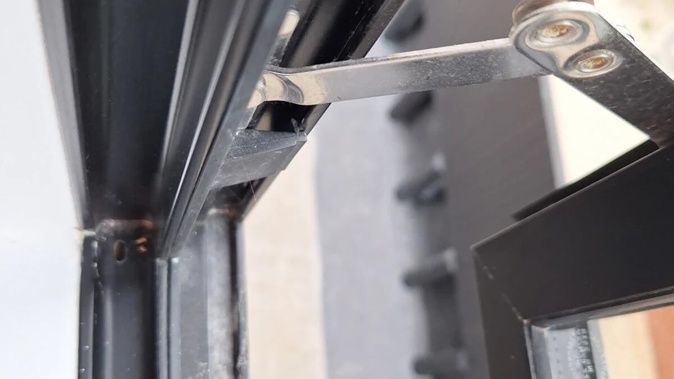
By Krystal Gibbens of RNZ
The owners of some new-build townhouses in Auckland say their homes cost twice as much to cool over summer as they do to heat in winter.
The million-dollar homes have just one heat pump installed on the second storey of the three-storey homes to cool the whole house, leaving the bedrooms on the third floor unbearably hot.
One homeowner, Meg*, said she believed insufficient thought had been put into the design from the start, with a west-facing aspect exposing it to a lot of sunlight, with windows that only opened a fraction for natural ventilation.
“It’s not rocket science to work out that actually the sun is going to heat up the house, especially the top two floors.
“If I had the blinds up [in the afternoon] it was unbearable. So I learned to put the blinds down early in the morning if I was going out.”
Meg said in one instance, the temperature in her bedroom was 30C at 9pm, while outside it was 24C.
She said the bedroom was “unliveable” and it got to the point where she was considering dragging her mattress to a lower level of the house.
“Which is not ideal - and frustrating having just bought a new home.”
She said she had been quoted $17,000 to fix the problem, but felt it should have been done at the build stage.
“When I purchased, I did not anticipate spending thousands more to make my home liveable.”
Ann*, who lives in a neighbouring property, has faced the same issues.
/cloudfront-ap-southeast-2.images.arcpublishing.com/nzme/H33VL5XHAVBJXP3N3YUOYPNQQQ.png)
One owner's bedroom had a temperature of 30C at 9pm.
“There’s been a handsome profit enjoyed by the vendor,” she said.
She said her new home was costing her, with both the power bills for cooling her home and the cost to remedy the problem.
“It’s going to cost us another $25,000,” she said to cool the home throughout.
On a day that was 24C, she said her house would be between 28C and 32C.
Thousands of people at risk
Green Council chief executive Andrew Eagles said overheating could be a big issue in new builds.
“There’s no requirement in the Building Code to address overheating,” he said. “So with modern homes being more airtight and at greater density, with high levels of insulation, it can be an issue.
“It’s really important that we improve the Building Code,” Eagles said.
He said several factors caused overheating in homes.
Having more townhouses or apartments meant less potential for cross-ventilation, he said.
Cities were also heating up, due to what was known as the urban heat island effect.
“We see the heating-up in cities and dense environments because of the concrete and glazing bouncing off each other and heating things up,” Eagles said.
Increasing temperatures both in New Zealand and globally also meant new homes needed to be built to accommodate this.
/cloudfront-ap-southeast-2.images.arcpublishing.com/nzme/MHSX7ZKILBBG7IQVQX2FWJ5A5M.png)
In some cases windows cannot be opened very far, limiting cooling.
“Each year we’re building 40,000 new homes and we are not considering overheating adequately in the new homes we’re building.”
He said that could lead to tens of thousands of people being at risk of “extremely uncomfortable environments” in their homes.
“We really need to get healthier, more comfortable [homes] and that means improving the Building Code.”
He said other countries had already made such improvements and New Zealand needed to follow suit.
Building passive
Team Green Architects owner Sian Taylor is a certified passive house designer.
Passive houses use building design to create energy efficient homes that require minimal energy for heating or cooling.
Taylor said some of the aspects they considered when designing a home included the orientation of the house to the sun, and the climate of the area.
“If you’re not a north-facing site, then you just have to really think about capturing that sun into the building and one of the biggest challenges is overheating.”
As buildings became more airtight, ventilation also played a key role.
Taylor said many buildings in New Zealand did not have ventilation systems and the country needed to ventilate better.
“I think active ventilation is something that we should all be now doing,” she said.
“We’ve got the knowledge, we’ve got the technology and it’s actually not that hard. We’re just not doing it.”
But she said that did not negate the need for natural ventilation, which was still key.
The high cost of retroactive installation
Director of Craft Homes Toby Tilsley, who installs mechanical ventilation systems, said it was much more expensive to retroactively install a system than to include it in the build.
“The system’s the same price, all the material that goes into the ventilation systems all very similar, but it’s all the demolition and all the rework that needs to be done to the home.
“When you retrofit the ventilation system, you have to then rip down walls, cut holes you have to fill them back in, repaint them.”
He said a system that was installed during building was installed before those elements were completed.
For a standard 200sq m New Zealand home, a mechanical ventilation system would cost on average around $15,000 but if installed retroactively it could cost more than $20,000-30,000.
“It could even get up to double.”
MBIE’s response
“The Building Code (G4 Ventilation) requires spaces in buildings to be provided with adequate ventilation consistent with their maximum occupancy and intended use,” MBIE manager building performance and engineering Dave Gittings said in response to questions from RNZ.
“The Ministry of Business, Innovation and Employment (MBIE) works with the sector to ensure that buildings in New Zealand are safe, healthy, and durable. MBIE regularly consults on, and updates, the Building Code documents to ensure it keeps pace with modern methods of construction, products, and technologies. We are committed to updating the Building Code so that it keeps step with innovation and the needs of modern society.”
* Some names have been changed.
- RNZ
Take your Radio, Podcasts and Music with you









